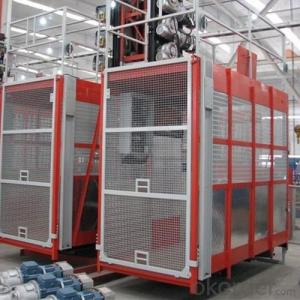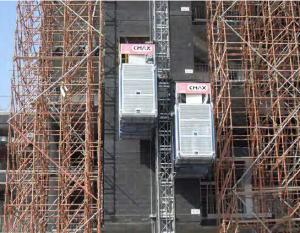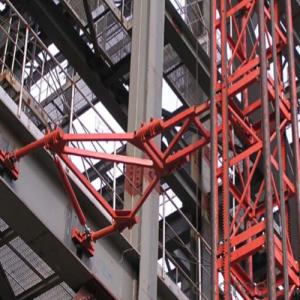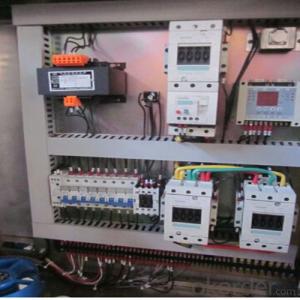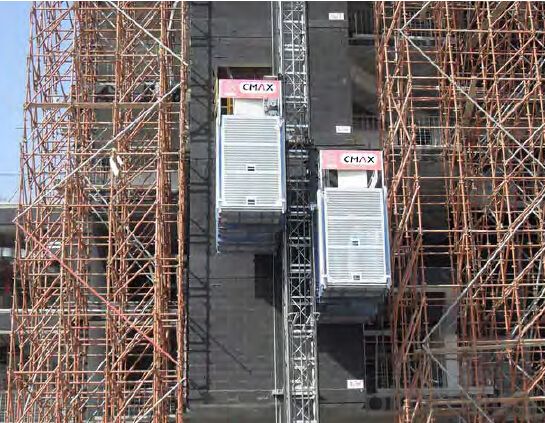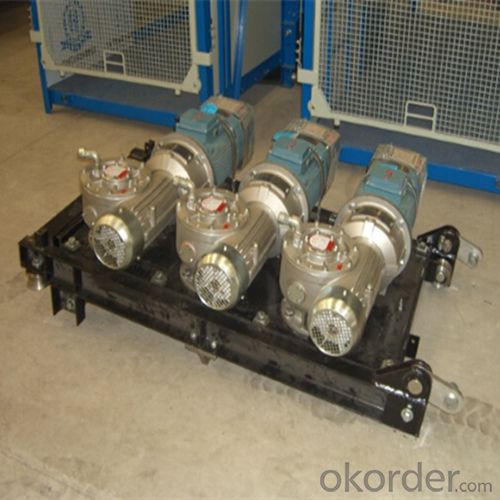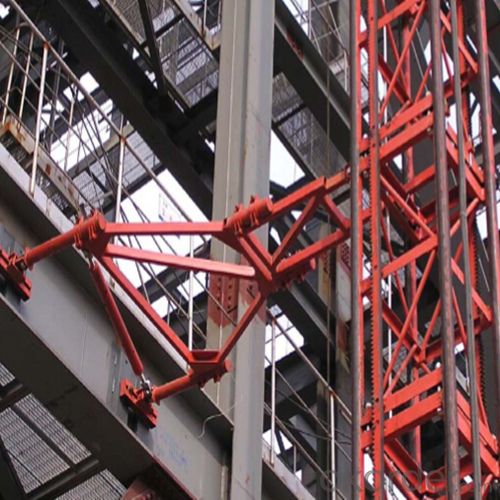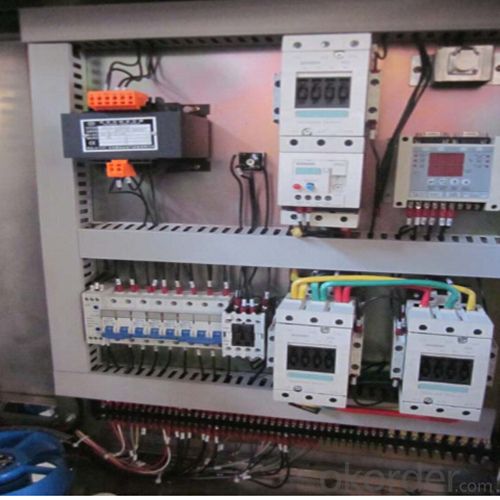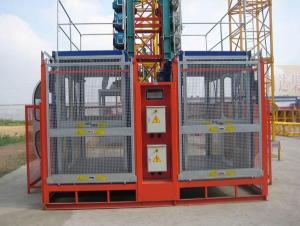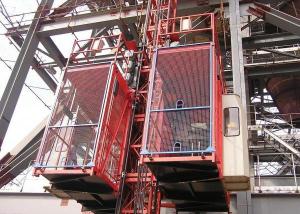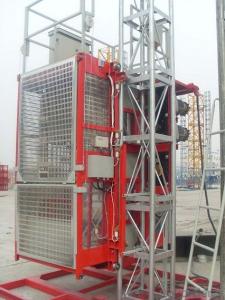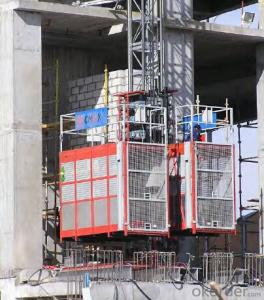Construction Hoist SC120Z,Gearing Adopts Imported Bearing, Enameled Cable, and Oil Seal
- Loading Port:
- China main port
- Payment Terms:
- TT or LC
- Min Order Qty:
- 1 unit
- Supply Capability:
- 30 unit/month
OKorder Service Pledge
OKorder Financial Service
You Might Also Like
SC Hoist is a Rack and Pinion EL. Lift, used on construction site for transportation of personnel and materials. It is installed and dismounted conveniently and can grow as high as the buildings grow in height.
There are single cage and twin cage hoists. A single cage can be quickly transformed into twin cage hoist by adding a cage and other parts. The hoist payload can be increased by adding counterweight equipment.
SC Hoist has reliable electrical and mechanical safety device. It is a efficient and safety vertical transporting equipment.
Structure of Construction Hoist Description
Feature: Construction Hoist Condition: New Application: Construction
Payload(kg):2700 Lifting Speed(m/min):33 Motor Power(kw): 3*15
Safety Device: SAJ50-1.2 Cage: Single Counterweight: No
Certification: CE,ISO Place of Origin: China(Mainland) Model Number: SC120Z
Construction Hoist Specifiction
Main technical data | Unit | Value |
Rated load | kg | 1200 |
Rated erection load | kg | 1000 |
Jib attachment rated load | kg | 300 |
Cage size | m | 3.0×1.3×2.5 |
Maximum lifting height | m | 450 |
Lifting speed | m/min | 0~63 |
Rated output | kw | 3×15 |
Voltage rating | V | 380/440 |
Rated frequency | Hz | 50/60 |
Rated current | A | 3×32.2 |
Power supply fuses | A | 125 |
Protective class | / | IP55 |
Load duration factor | / | FC-25% |
Safety device | m/s | 1.4 |
Enclosure weight | kg | 980 |
Cage weight | kg | 2000 |
Counterweight | kg | / |
Mast section weight | kg | 125/145 |
Mast section length | mm | 1508 |
Packaging & Delivery of Construction Hoist
Packaging Detail: Nude package Delivery Detail: 25-30days
Building hoist inmmages
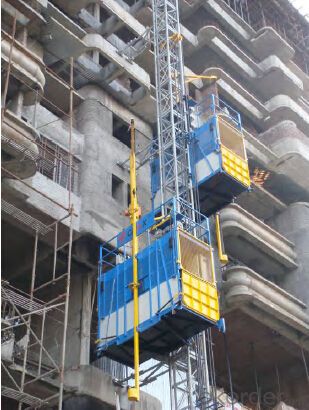
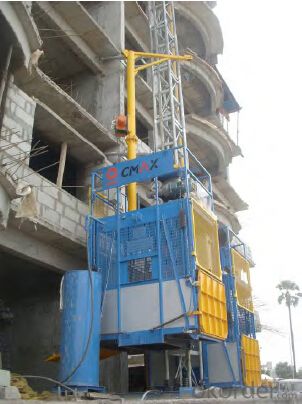
Main Parts of Construction Hoist
● The gearing adopts imported bearing, enameled cable, and oil seal.
● The electric parts adopt products from world renowned manufactures such as Schneider, Siemens, and LG.
● The racks and pinion adopts special material and heat-treatment technique, which prolong the life of these parts.
● The steel structure uses quality steel from famous domestic manufactures.
● The surface of the structure can apply paint-spray, parkerozing baking finish or hot galvanizing processing according
to users requirements,
● The cage can be produced and decorated by aluminum molded board, punched-plate or figured aluminm board.
FAQ of Construction Hoist
Q: What is the building hoist main purpose?
A: Building hoist equipped with double or single cabin to transport the materials and labors up and down. It's the ideal
construction equipment for vertical transportation in the field of construction.
Q: What is the main structure of building hoist?
A: The P/M construction hoist mainly contains metal structure, driving system, electrical control system, cable guide &
protection system, electrical top crane and safety device.
Q: What is the meaning of the building hoist’s code?
A: Take SC200/200 for example: “SC” stands for rack and pinion hoist, “200/200” stands for double cage and capacity
is 2 tons per cage. “SC200” stands for single cage and capacity is 2 tons.
Q: What is the dimension of the cage?
A: Normally the cage dimension is 3X1.5X2.5M (L/W/H) for 2t type hoist. Details should be checked according to our
quotation sheet. Also, the size can be customized according to the factual site condition. There are two doors (entrance
& exit doors) for each cage, It can be produced as up & down sliding or ramping model for safety and convenience.
- Q: Describe the routine maintenance and inspection procedures for a building hoist.
- <p>The maintenance and inspection process for a building hoist involves several key steps to ensure safety and functionality. Regular visual inspections should be conducted to check for any visible damage or wear. Monthly inspections should include testing the emergency stop and limit switches, as well as lubricating moving parts. Quarterly inspections may involve checking the electrical connections and verifying the correct operation of safety devices. Annual inspections typically require a thorough examination by a qualified person, including testing the load-bearing capacity and ensuring all safety features are in good working order. Additionally, records of all inspections and maintenance should be kept for reference and compliance with safety regulations.</p>
- Q: Can a building hoist be utilized for the transportation of objects within and between buildings?
- <p>Yes, building hoists are specifically designed to move objects vertically within buildings. They are commonly used in construction to lift materials and equipment to different floors. Additionally, they can be employed to transport objects into and out of buildings, especially when access is limited or when heavy loads need to be moved over short vertical distances. However, it's important to adhere to safety guidelines and regulations when operating a building hoist to ensure the secure and efficient movement of objects.</p>
- Q: This question asks about the steps or measures to ensure the safe installation of a building hoist, which is a device used in construction for lifting materials and personnel.
- <p>To install a building hoist safely, follow these steps: 1. Ensure the site is clear and secure, with proper access and no obstructions. 2. Check that the hoist is suitable for the load and building structure. 3. Assemble the hoist according to the manufacturer's instructions. 4. Install the hoist on a stable and level base, ensuring it is securely anchored to the building. 5. Conduct a thorough inspection of all components for any defects or damage. 6. Test the hoist with a trial run to ensure all functions work correctly. 7. Train operators on the safe use and operation of the hoist. 8. Obtain any necessary permits and inspections from local authorities. 9. Regularly inspect and maintain the hoist to ensure ongoing safety.</p>
- Q: Is it possible to substitute an automatic lifting device with a manual one in construction projects?
- <p>While it is technically possible to use a manual lifting device in place of an automatic one for certain construction tasks, it is not generally recommended. Manual lifting devices are typically less efficient, slower, and can pose safety risks due to the physical effort required. They may also not meet the load-bearing requirements of heavy construction materials. Automatic lifting devices are designed for efficiency, safety, and to handle heavy loads, making them more suitable for construction work. It's crucial to adhere to safety standards and use appropriate equipment for the task at hand.</p>
- Q: Is it possible to operate building hoists in cold weather conditions?
- <p>Yes, building hoists can be used in cold climates, but they must be designed and maintained for such conditions. Cold weather can affect the performance of hoists, so it's crucial to use hoists specifically engineered for low-temperature operation. Regular maintenance and checks are necessary to ensure safety, as extreme cold can cause metal parts to contract and lubricants to thicken, affecting the hoist's functionality. Always follow the manufacturer's guidelines for operating hoists in cold climates.</p>
- Q: Is it possible to replace a building hoist with an electric winch for the purpose of lifting materials or individuals?
- <p>While theoretically possible, using an electric winch instead of a building hoist for lifting materials or people is not recommended due to safety concerns and differences in design. Electric winches are typically designed for pulling or towing loads and may not have the necessary safety features, load capacity, or stability required for lifting operations in a construction setting. Building hoists are specifically engineered to lift heavy materials and personnel safely in vertical shafts or on the facade of a building. They are equipped with safety devices and are regulated for construction use, making them the appropriate choice for such tasks.</p>
- Q: Elevator installation approach, need to give the total package (inspect) what data, come a master to answer the detail point
- Supplement: Component members: project manager, safety personnel, inspectors, field director, technical director, foreman, elevator operation (mechanical, electrical installation and maintenance) welders, electricians, scaffolder, etc. The subcontract unit project manager shall have a certificate of construction, and special work shall be given the special work certificate. If the special work certificate is outside the province and province, the construction committee of the construction site should be put on the record.
- Q: This question asks about the method to determine the maximum weight a building hoist can safely support.
- <p>Calculating the maximum load capacity of a building hoist involves several factors. First, consider the hoist's mechanical design and the manufacturer's specifications, which provide the rated load capacity. This is the maximum weight the hoist is designed to handle. Next, assess the condition of the hoist, as wear and tear can reduce its capacity. Additionally, consider the strength of the supporting structure and the safety factor, which is typically a multiplier of the rated load capacity to ensure safety. For example, if the hoist is rated for 1000 kg, a safety factor of 1.5 means the actual maximum load should not exceed 667 kg (1000 kg / 1.5). Always consult with engineers and follow local regulations and standards for precise calculations.</p>
- Q: Identify the elements that influence the durability and operational lifespan of lifting machinery, specifically focusing on Building Hoists.
- <p>The lifespan of lifting equipment, including Building Hoists, is influenced by several factors: 1) Material Quality: The type and quality of materials used in construction directly affect durability and resistance to wear and tear. 2) Design and Engineering: Proper design ensures optimal performance and reduces stress on components. 3) Frequency of Use: More frequent use can lead to faster wear and tear. 4) Maintenance and Repair: Regular maintenance can extend the lifespan, while neglect can shorten it. 5) Operating Conditions: Environmental factors such as temperature, humidity, and exposure to corrosive substances can impact longevity. 6) Load Capacity: Overloading can cause premature failure. 7) Compliance with Safety Standards: Adhering to safety guidelines can prevent accidents and damage. 8) Technological Advancements: Newer models may have improved features that extend lifespan.</p>
- Q: Is it possible to utilize a building hoist for the purpose of raising construction materials or machinery?
- <p>Yes, a building hoist is specifically designed for lifting materials and equipment in construction settings. It is a temporary vertical transportation system used to move materials, tools, and sometimes personnel between different floors of a building under construction. Building hoists are essential for efficient construction processes, ensuring that materials are delivered to the correct levels without the need for manual labor, which can be time-consuming and hazardous.</p>
Send your message to us
Construction Hoist SC120Z,Gearing Adopts Imported Bearing, Enameled Cable, and Oil Seal
- Loading Port:
- China main port
- Payment Terms:
- TT or LC
- Min Order Qty:
- 1 unit
- Supply Capability:
- 30 unit/month
OKorder Service Pledge
OKorder Financial Service
Similar products
Hot products
Hot Searches
Related keywords
